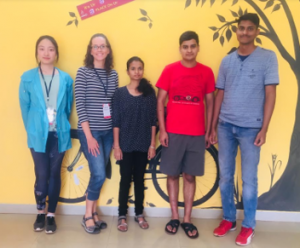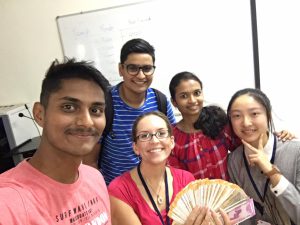Prior to arriving in Hubli, I knew that the GE2 program would include significant group work. I also knew that the program was compressed, but for some reason I did not expect to be put into groups on the first day. However, group assignments happened almost immediately and I have really enjoyed working with my small team thus far! We are comprised of 3 undergraduate engineering students (2 from India and 1 from America), 1 undergraduate finance student (from China), and myself, an American engineer pursuing my master’s degree. Though we come from different cultural and academic backgrounds, the team dynamic has been great as all members have proven to be strong contributors.

One assignment that really brought us together as a team was the “500 Rupee Challenge”, in which all teams were tasked with raising as much money as possible in 2-days by creating a venture from an initial investment of 500 INR. The proceeds from each venture would ultimately be donated to charity. Initial brainstorming almost immediately led us into the “storming” stage of team development as we discussed and challenged the feasibility of each other’s product ideas. But, we all maintained respectful communication and steadily discussed different options until we found one we could agree on.
An idea that I suggested was creating a business around the concept of charitable fundraising. I noted that I had personally experienced and observed resistance to international charitable giving because there was little visibility into how the funds would be distributed and used. To my surprise, my Indian teammates were cynical about pursuing a venture that relied upon, or even mentioned proceeds going to charity. I chose to ask more about this and was told that most Indians are skeptical about donating to charity because they do not trust that donated funds will actually be used by the charity. This is certainly a large cultural difference between Indians and Americans, who regularly donate to a variety of charities as their funds allow. Upon further reflection I remembered that my previous travels taught me that donating to charity is also uncommon in Thailand and Laos. I believe this trend likely continues to other parts of Asia, though I have not personally verified this.
As we continued discussing possible product offerings for our charitable fundraising campaign, we recognized that we had easy access to locally-made Indian handicrafts, and our team could collectively write in four different languages. When we talked about who might be interested in these things, it became obvious that other GE2 Program participants would not be our target market since they shared these traits. So, we considered members of our personal networks. We quickly concluded that our American contacts would be the best target market because they do not have easy access to Indian handicrafts, and they would be most interested in supporting a business that was raising money for charity. Furthermore, our team identified that we could offer value to these customers by facilitating a safe and trusted means of giving to an Indian charity. So, we went to work on developing a fundraising campaign that would sell Indian handicrafts and customized trinkets at an elevated rate, with proceeds going to the specified charity. In our campaign ad we noted that it was acceptable to provide a donation only, in which case our product would be the secure transfer of funds, as previously discussed.
Moving into the “norming” phase of team development, each member contributed to the effort and distributed our marketing campaign through online channels, albeit with some continued uncertainty from the Indian teammates. It was after our first sale that we moved into the “performing” phase. Our success was motivating for us, and it brought us together as a team. The experience was certainly positive from the student perspective, but it will be far more rewarding when we personally deliver the proceeds to the charity!

